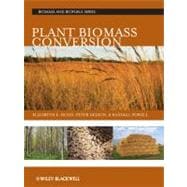
Note: Supplemental materials are not guaranteed with Rental or Used book purchases.
Purchase Benefits
What is included with this book?
Peter Nelson is a principal in BioDimensions, providing services for startup companies developing green technology.
Randy Powell, Ph.D, is the president of Powell Consulting, LLC, a construction consulting firm promoting biofuel and bioproducts.
| Introduction | |
| Biofuels and BioâÇôbased products—a new era of products from renewable sources. (Beth and Pete). This is the introduction to the whole book focus. It should be focused on what is possible from biomaterials—chemicals and fuels. Diversity of crop and animal feedstocks are also important although this book will focus on plant feedstocks. Volumes of feedstocks necessary to meet the needs | |
| Feedstocks—near and far term | |
| Agricultural and forest residues—This will focus on the first wave of feedstocks for the renewable industry—rice straw, corn stover, wheat straw, cotton trash, etc., even forest slash and sawdust | |
| Woody crops—Steve Strauss—this will focus on hybrid poplar as a feedstock for biomass | |
| MSW—Bill Ort to suggest a potential author—for cities, this is an additional feedstock to crop feedstocks. This prevents build up of municipal solid waste. Need to show the volumes available | |
| Miscanthus—Mendel (Neal?)—Advantages and disadvantages; will the USDA allow this nonâÇônative plant on a large scale? | |
| Switchgrass—Ceres (Steve?)—Advantages and disadvantages; what are the issues to high production from this plant? | |
| Other energy crops—Arundo, etc (Peggy OziasâÇôAkins)—what are the advantages and disadvantages of this crop? | |
| Soil and water sustainability | |
| Soil and water sustainability for biofuel production—Steve Green and Jennifer Bouldin—If we harvest the biomass that is usually left on the ground in noâÇôtill agriculture, what are the consequences to the soil.? How much water will this take? | |
| Technology | |
| Enzymes—Production systems (Beth and John Howard) | |
| Transgenic Plants—seed and biomass | |
| Fungal fermentation | |
| Enzyme quality and specific activity | |
| Enzyme cocktails—biochemistry | |
| Pretreatment options—this is current technology that will be deployed for the early production plants. (Michael Ladisch, Andy Aden, Bruce Dale) | |
| Steam | |
| Acid | |
| Ammonia | |
| Advanced pretreatment options | |
| Fermentation Organisms—for 5 and 6 carbon sugars | |
| Pilot and Production plants | |
| Summary and analysis of those funded by DOE—useful to know who has been funded and what type of technology is being deployed in these plants. Other, nonâÇôDOE funded facilities | |
| NonâÇôUS facilities and technologies | |
| Economics—Economics chapter: (Marie Walsh?)—What will drive this industry? Sustainability | |
| Summary | |
| Future directions—new technologies | |
| Book summary | |
| Table of Contents provided by Publisher. All Rights Reserved. |
The New copy of this book will include any supplemental materials advertised. Please check the title of the book to determine if it should include any access cards, study guides, lab manuals, CDs, etc.
The Used, Rental and eBook copies of this book are not guaranteed to include any supplemental materials. Typically, only the book itself is included. This is true even if the title states it includes any access cards, study guides, lab manuals, CDs, etc.